Some Quick Gaming Numbers at 4K, Max Settings
by Ian Cutress on July 1, 2013 8:00 AM ESTPart of my extra-curricular testing post Computex this year put me in the hands of a Sharp 4K30 monitor for three days and with a variety of AMD and NVIDIA GPUs on an overclocked Haswell system. With my test-bed SSD at hand and limited time, I was able to test my normal motherboard gaming benchmark suite at this crazy resolution (3840x2160) for several GPU combinations. Many thanks to GIGABYTE for this brief but eye-opening opportunity.
The test setup is as follows:
Intel Core i7-4770K @ 4.2 GHz, High Performance Mode
Corsair Vengeance Pro 2x8GB DDR3-2800 11-14-14
GIGABYTE Z87X-OC Force (PLX 8747 enabled)
2x GIGABYTE 1200W PSU
Windows 7 64-bit SP1
Drivers: GeForce 320.18 WHQL / Catalyst 13.6 Beta
GPUs:
| NVIDIA | ||||||
|---|---|---|---|---|---|---|
| GPU | Model | Cores / SPs | MHz | Memory Size | MHz | Memory Bus |
| GTX Titan | GV-NTITAN-6GD-B | 2688 | 837 | 6 GB | 1500 | 384-bit |
| GTX 690 | GV-N690D5-4GD-B | 2x1536 | 915 | 2 x 2GB | 1500 | 2x256-bit |
| GTX 680 | GV-N680D5-2GD-B | 1536 | 1006 | 2 GB | 1500 | 256-bit |
| GTX 660 Ti | GV-N66TOC-2GD | 1344 | 1032 | 2 GB | 1500 | 192-bit |
| AMD | ||||||
| GPU | Model | Cores / SPs | MHz | Memory Size | MHz | Memory Bus |
| HD 7990 | GV-R799D5-6GD-B | 2x2048 | 950 | 2 x 3GB | 1500 | 2x384-bit |
| HD 7950 | GV-R795WF3-3GD | 1792 | 900 | 3GB | 1250 | 384-bit |
| HD 7790 | GV-R779OC-2GD | 896 | 1075 | 2GB | 1500 | 128-bit |
For some of these GPUs we had several of the same model at hand to test. As a result, we tested from one GTX Titan to four, 1x GTX 690, 1x and 2x GTX 680, 1x 660Ti, 1x 7990, 1x and 3x 7950, and 1x 7790. There were several more groups of GPUs available, but alas we did not have time. Also for the time being we are not doing any GPU analysis on many multi-AMD setups, which we know can have issues – as I have not got to grips with FCAT personally I thought it would be more beneficial to run numbers over learning new testing procedures.
Games:
As I only had my motherboard gaming tests available and little time to download fresh ones (you would be surprised at how slow in general Taiwan internet can be, especially during working hours), we have a standard array of Metro 2033, Dirt 3 and Sleeping Dogs. Each one was run at 3840x2160 and maximum settings in our standard Gaming CPU procedures (maximum settings as the benchmark GUI allows).
Metro 2033, Max Settings, 3840x2160:
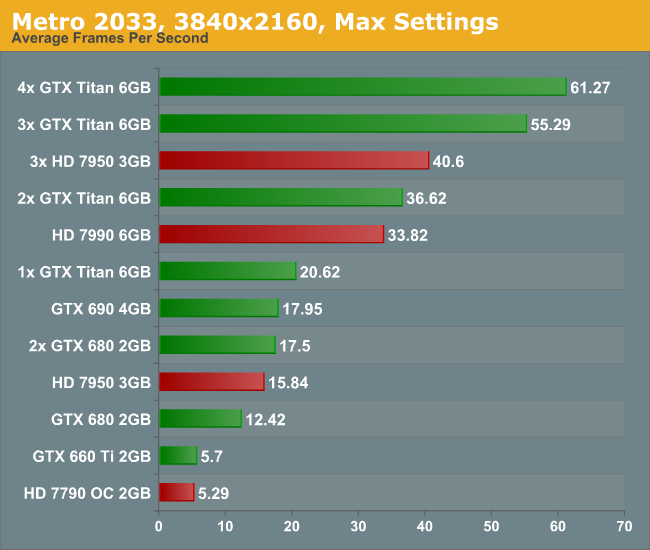
Straight off the bat is a bit of a shocker – to get 60 FPS we need FOUR Titans. Three 7950s performed at 40 FPS, though there was plenty of microstutter visible during the run. For both the low end cards, the 7790 and 660 Ti, the full quality textures did not seem to load properly.
Dirt 3, Max Settings, 3840x2160:
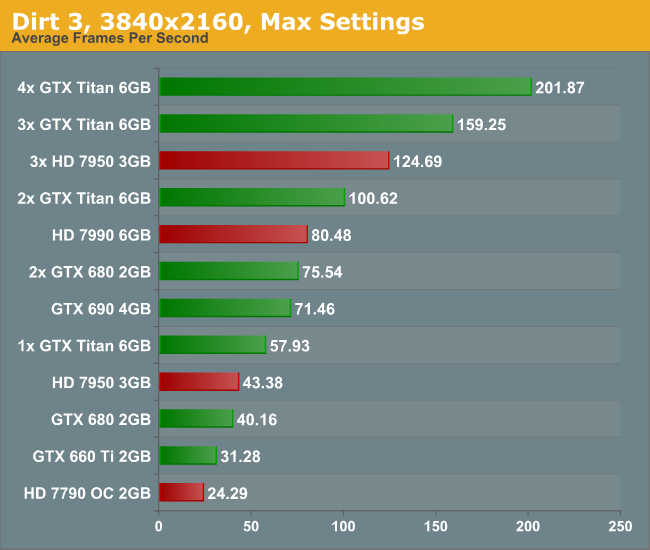
Dirt is a title that loves MHz and GPU power, and due to the engine is quite happy to run around 60 FPS on a single Titan. Understandably this means that for almost every other card you need at least two GPUs to hit this number, more so if you have the opportunity to run 4K in 3D.
Sleeping Dogs, Max Settings, 3840x2160:
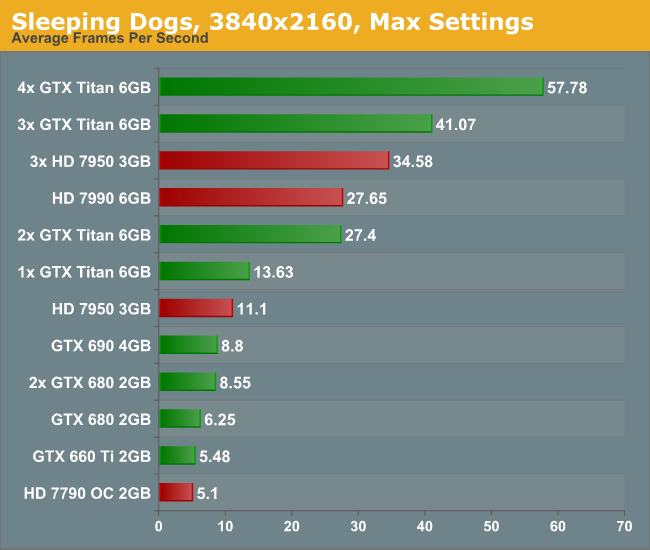
Similarly to Metro, Sleeping Dogs (with full SSAA) can bring graphics cards down to their knees. Interestingly during the benchmark some of the scenes that ran well were counterbalanced by the indoor manor scene which could run slower than 2 FPS on the more mid-range cards. In order to feel a full 60 FPS average with max SSAA, we are looking at a quad-SLI setup with GTX Titans.
Conclusion:
First of all, the minute you experience 4K with appropriate content it is worth a long double take. With a native 4K screen and a decent frame rate, it looks stunning. Although you have to sit further back to take it all in, it is fun to get up close and see just how good the image can be. The only downside with my testing (apart from some of the low frame rates) is when the realisation that you are at 30 Hz kicks in. The visual tearing of Dirt3 during high speed parts was hard to miss.
But the newer the game, and the more elaborate you wish to be with the advanced settings, then 4K is going to require horsepower and plenty of it. Once 4K monitors hit a nice price point for 60 Hz panels (sub $1500), the gamers that like to splash out on their graphics cards will start jumping on the 4K screens. I mention 60 Hz because the 30 Hz panel we were able to test on looked fairly poor in the high FPS Dirt3 scenarios, with clear tearing on the ground as the car raced through the scene. Currently users in North America can get the Seiki 50” 4K30 monitor for around $1500, and they recently announced a 39” 4K30 monitor for around $700. ASUS are releasing their 4K60 31.5” monitor later this year for around $3800 which might bring about the start of the resolution revolution, at least for the high-end prosumer space.
All I want to predict at this point is that driving screen resolutions up will have to cause a sharp increase in graphics card performance, as well as multi-card driver compatibility. No matter the resolution, enthusiasts will want to run their games with all the eye candy, even if it takes three or four GTX Titans to get there. For the rest of us right now on our one or two mid-to-high end GPUs, we might have to wait 2-3 years for the prices of the monitors to come down and the power of mid-range GPUs to go up. These are exciting times, and we have not even touched what might happen in multiplayer. The next question is the console placement – gaming at 4K would be severely restrictive when using the equivalent of a single 7850 on a Jaguar core, even if it does have a high memory bandwidth. Roll on Playstation 5 and Xbox Two (Four?), when 4K TVs in the home might actually be a thing by 2023.
16:9 4K Comparison image from Wikipedia


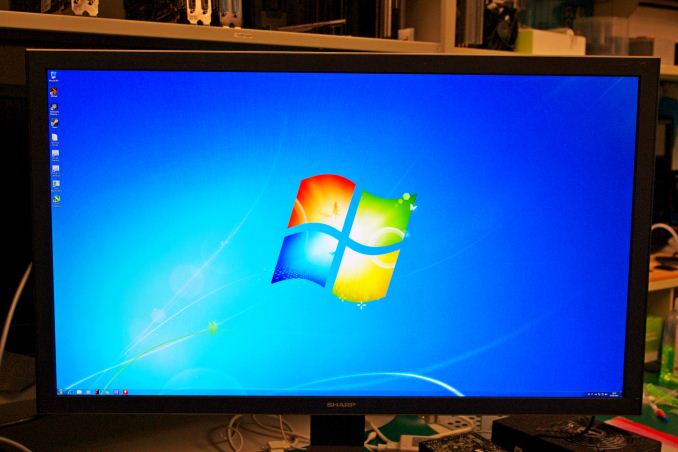

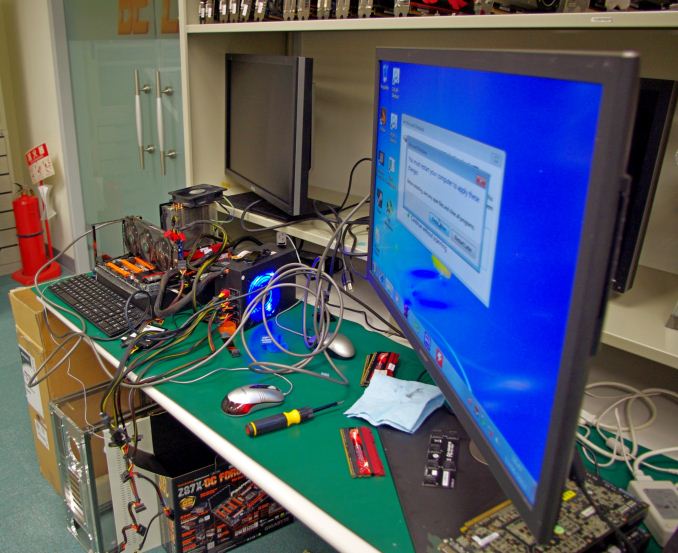

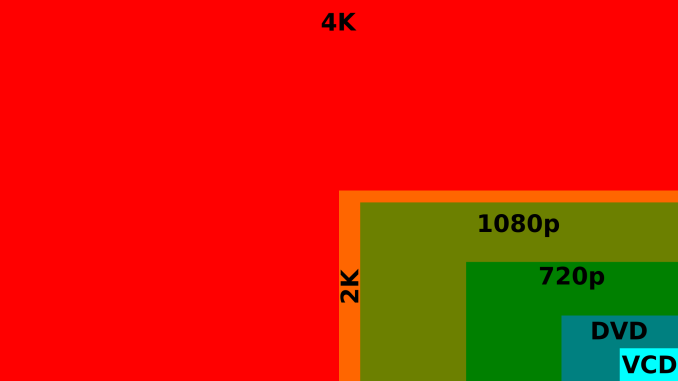








134 Comments
View All Comments
MordeaniisChaos - Sunday, July 7, 2013 - link
Actually, some sort of comparison of "jaggedness" on a 4k screen vs a 1080 screen would be really nice to see. I'm curious just how much better the PPI will actually make edges look. I'm sure it won't eliminate jagged edges, but surely more than 2xSomethingAA would be enough. Only logical considering a lot of games don't benefit from 8x over 4xMSAA in any meaningful way. And something like 2xTXAA would probably look fantastic. The resolution helps with the blurring issue (which I never minded or really noticed too much, I was happy to have clean, smooth, non-crawling edges), and 2xTXAA should be pretty easy to run. Hell, and I can't believe I'm saying this, but maybe even... FXAA won't look terrible at those resolu-... *barfs* nope, can't say it.designerfx - Monday, July 1, 2013 - link
wait, so a hd 7990 6gb beats out a single titan?that's quite interesting. I wonder what would have happened with 2 HD 7990 6GB's?
nakquada - Monday, July 1, 2013 - link
A 7990 is effectively somewhere between 2 x 7970 and 2 x 7970 Ghz edition. So a single 7990 would be much faster than a Titan. They are however in now way in competition as AMD doesnt have a Titan-class single GPU. Its 7990 is head-to-head with a GTX 690 (which itself is effectively 2 x 680s)Bandanawedgie - Monday, July 1, 2013 - link
Perhaps 4x 7970s would be better, as Toms Hardware struggled to get 2 to run without heat issues.mapesdhs - Tuesday, July 2, 2013 - link
It isn't a 7990 6GB. Each GPU has 3GB, so that's the max VRAM the host system
can use. Adding the VRAM of each GPU is misleading marketing. Find a gaming
test that runs on a Titan using (say) 4GB VRAM (eg. heavily modded Skyrim at
mega res and AA), try it on a 7990, it'll tank.
Ian.
Civver27 - Monday, July 1, 2013 - link
Interesting, but how much difference to the frame-rate it would have made it running the cpu at stock on the the 4 gpu setup and single GPU setup. That way we would all know to waht degree -that clocking your cpu to 5GHz really benefits your frame rates at these resolutions which is only the price ot 4 * 1080p monitorsEzioAs - Monday, July 1, 2013 - link
I think at this high resolution, we won't (or shouldn't) be seeing the CPU bottleneck, but rather GPU bottleneck. So, running the CPU at stock speeds or overclocked won't (shouldn't) make a difference. If there is one, it's probably very miniscule.EzioAs - Monday, July 1, 2013 - link
Actually, looking at the numbers back, Metro 2033 is probably the only title that has a CPU bottleneck with 4xTitan, although that could also be quad-SLI not scaling properly.Kevin G - Monday, July 1, 2013 - link
I'd expect to see a difference between PCI-E 2.0 and 3.0 as well as 8x and 16x lane configurations since SLI/CrossFire is really helpful at 4k. This would place socket 2011 chips at an advantage here.jrs77 - Monday, July 1, 2013 - link
I've said it before, and I'll say it again... 4k resolution is total bollocks and offers no improvements over the current 1080p standard.High density screens are for mobile devices, where you look at them from 30cm distance. And for this area it's allready hitting the same wall as the 1080p resolution for TVs.
Usually you sit some 70cm away from your PC-screen, or in a more ergonomic way, the length of your arm. At this distance tho, you won't really see single pixels anymore on a 22-24" 1080p screen, especially when talking about movies or games instead of still images.
For a TV in the living-room, the rule of thumb is 1m distance for every 15". So you'll sit at some 3m distance when looking at a 40" TV. At this distance you won't notice too much differences between 1080p and 4k. So the only thing a 4k-resolution does really is to unnecessarily increase bandwith or storagespace.
For games... yeah... look at the results there. Quad-Titan Setup to get 60FPS in Metro 2033 or Sleeping Dogs. This is the totally wrong direction imho. We want hardware that can drive 4k-resolutions, but at the same time we all know that energy isn't getting any cheaper. And to have a PC that sucks 1kW while playing a video-game :cough: sorry, but that's just stupid.
Leave it at 1080p and get me hardware that allows me to play games like Metro at max settings with only 100-150W for the complete system, i.e. 35W TDP CPU + 75W TDP GPU (75W is the maximum powerdraw over PCIe x16, so no extra PCIe-powerconnector).